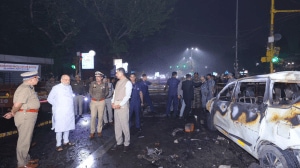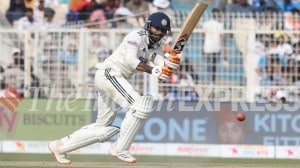A foreign policy for the polls?
The alarums over President Pervez Musharraf’s videotaped message to the India Today Conclave, his subsequent elevation by Colin Powell ...

The alarums over President Pervez Musharraf’s videotaped message to the India Today Conclave, his subsequent elevation by Colin Powell to the exalted rank of Washington’s Most Important Non-NATO Ally, and his recent reiteration in a press interview of his view on Jammu and Kashmir all go to underline the fragility of the dialogue that was allegedly initiated on the margins of the SAARC summit in Islamabad on the eve of the BJP decision to call an early general election.
The root of the fragility is Atal Bihari Vajpayee’s motivation. Believing that a dramatic gesture would pay him political dividends, he went into a U-turn at the summit that he almost did not attend. Readers with longer memories than complaisant editorialists would recall the unpardonable rudeness of External Affairs Minister Yashwant Sinha in refusing to allow the Pakistani foreign minister, Khurshid Mehmood Kasuri, to even visit New Delhi to discuss something so innocuous as the SAARC summit. Till the last minute, the nation and the world were kept guessing whether Vajpayee would even go. When eventually he arrived in Islamabad, the one-point agenda was cosmetics to pretend a breakthrough had taken place.
 To achieve this synthetic objective, the Vajpayee administration abandoned all it had been saying about Pakistan as a terrorist state. Suddenly Pakistan was not a military dictatorship but a fledgling democracy; suddenly Musharraf was not the Butcher of Kargil but a valid interlocutor. All talk of the 20 Most Wanted went through the window. Vajpayee did not once mention the assault on Parliament that he and his government had till then insisted was masterminded by Pakistan. No mention either of Akshardham, which his deputy, L.K.Advani, had portrayed as a Pakistani machination. No explanation was offered about why the two nuclear neighbours were taken to the brink of war. Above all, it was Vajpayee’s abandonment of his oft-reiterated pre-conditions for a dialogue with Pakistan that showed how far electoral considerations were fuelling foreign policy.
To achieve this synthetic objective, the Vajpayee administration abandoned all it had been saying about Pakistan as a terrorist state. Suddenly Pakistan was not a military dictatorship but a fledgling democracy; suddenly Musharraf was not the Butcher of Kargil but a valid interlocutor. All talk of the 20 Most Wanted went through the window. Vajpayee did not once mention the assault on Parliament that he and his government had till then insisted was masterminded by Pakistan. No mention either of Akshardham, which his deputy, L.K.Advani, had portrayed as a Pakistani machination. No explanation was offered about why the two nuclear neighbours were taken to the brink of war. Above all, it was Vajpayee’s abandonment of his oft-reiterated pre-conditions for a dialogue with Pakistan that showed how far electoral considerations were fuelling foreign policy.As at Lahore 1998, so at Islamabad 2004, the NDA’s insistence on an end to cross-border terrorism and the dismantling of the infrastructure of terrorism were eschewed in favour of not even mentioning the words “cross-border terrorism” in the Islamabad communique merely because Musharraf would not have it. Vajpayee appeased Musharraf to get the communique he needed to go to the hustings. Thus was the dialogue launched.
The pre-conditions for dialogue were in any case absurd and their abandonment is all to the good. Ending cross-border terrorism should be the object of the exercise, not an unenforceable pre-condition to start the process. But the dialogue proper can be got going only if there is sincerity of intent, not if this is yet another election-eve gimmick. The very decision to postpone all matters of substance till after the elections shows that there is no substantive change in anyone’s position.
The foreign secretary’s visit to Islamabad in February was a cliched repetition of a process of dialogue already structured seven years earlier when I.K. Gujral was prime minister and Salman Haider his foreign secretary. Our Foreign Office has failed to appreciate that the Gujral-Haider model was stillborn because of flaws in its structure. First, the dialogue, as conceived at Murree in June 1997, was segmented — different interlocutors for different subjects, thus severely restricting the scope for inter-sectoral trade-offs which are the only way of securing on the swings what is lost on the roundabouts. Second, focusing the dialogue at the official level instead of raising it to a political level. The consequences of this have been seen in the dialogue with the NSCN (I-M), where a former home secretary has been given a sinecure to follow Isaac and Muivah around the world with no result for endless years, leaving the only movement forward to occur when Vajpayee receives the duo in Delhi bang on the eve of the Nagaland assembly elections. As with our worst internal insurgency, so with our worst proxy war, this government moves only when there is some petty political gain to be made.
The third flaw in the Gujral-Haider model became evident in the immediate aftermath of the agreement at Murree. Procedural squabbles over what should be discussed where, and the absence of any in-built periodicity to the process, resulted in the dialogue being engaged in fitfully with rancour filling the uncertain interval between successive rounds of substantive talks. The model we should be drawing on is the Hotel Majestic talks in Paris between Henry Kissinger and Ho Ch Minh’s representative, Le Duc Tho. Even as the interlocutors were mercilessly bombing each other, the dialogue went on. Every Thursday, without fail, for four long years from 1969 to 1973, the dialogue went on without interruption.
It could take at least as long for the India-Pakistan dialogue to reach fruition. If the dialogue is not insulated from the inevitable ups and downs of our bilateral relationship, it will not reach fruition. Therefore, Foreign Secretaries Shashank and Riaz Khokhar should have rethought the architecture of the dialogue instead of remaining caught in a flawed model. They should have talked of how often their delegations would meet — and where (my choice would be the Wagah-Attari border, so that neither Foreign Office can plead inconvenience to avoid inviting the other side). Leaving the dialogue to the whims of time and circumstance will only lead to disruption — as has repeatedly happened in the past.
The dialogue needs to be insulated also from global power politics. That was the great virtue of the Simla Agreement. It placed the dialogue firmly in the bilateral realm, away from outside influences that may have aims of their own, not germane to the concerns of the dialogue partners. Clearly, the Islamabad process was the outcome of intense US pressure on both Vajpayee and Musharraf to not distract Pakistan from the over-arching US aim of capturing Osama bin Laden before the US presidential elections in November.
For genuine peace to be established, it is an essential prerequisite that the dialogue be so structured as to make it uninterrupted and uninterruptible. For unless we get the architecture of the dialogue right, the dialogue will remain a house of cards to be blown away by the least storm in the India-Pakistan tea-cup.































